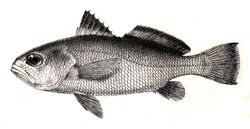Biology:Pennahia
| Pennahia | |
|---|---|

| |
| Scientific classification | |
| Domain: | Eukaryota |
| Kingdom: | Animalia |
| Phylum: | Chordata |
| Class: | Actinopterygii |
| Order: | Acanthuriformes |
| Family: | Sciaenidae |
| Genus: | Pennahia Fowler, 1926 |
| Type species | |
| Otolithus macrophthalmus | |
Pennahia is a genus of marine ray-finned fishes belonging to the family Sciaenidae, the drums and croakers. The fishes in this genus are found in the Indo-West Pacific region.
Taxonomy
Pennahia was first proposed as a subgenus of Johnius in 1926 by the American ichthyologist Henry Weed Fowler with Otolithus macrophthalmus, which had been described by Pieter Bleeker in 1849 from Jakarta, as the type species. O. macropthalmus was later shown to be synonymous with Johnius aneus, a species described by Marcus Elieser Bloch from Malabar in 1793.[1][2] This genus has been placed in the subfamily Otolithinae by some workers,[3] but the 5th edition of Fishes of the World does not recognise subfamilies within the Sciaenidae which it places in the order Acanthuriformes.[4]
Etymology
Pennahia derives from pinnah, a local Tamil name for the type species.[5]
Species
Pennahia contains the following recognised species:[6]
- Pennahia aneus (Bloch, 1793) (Donkey croaker)
- Pennahia argentata (Houttuyn, 1782) (Silver croaker)
- Pennahia macrocephalus (Tang, 1937) (Big-head pennah croaker)
- Pennahia ovata Sasaki, 1996
- Pennahia pawak (Lin, 1940) (Pawak croaker)
Characteristics
Pennahia croakers have a pair of pores on the tip of the chin, one on either side of the tip, and these are not connected by a groove. The swim bladder is shaped like a carrot and has branched appendages along the whole of each side with the forward most appendages not crossing the transverse septum. The branches have poorly developed upper limbs. The sagitta is shaped like a tadpole and hasi its "tail" only slightly arched.[7] The largest species in the genus is the silver croaker P. argentata which has a maximum published standard length of 40 cm (16 in) while the smallest P. ovata which has a maximum published standard length of 18.7 cm (7.4 in).[6]
Distribution
Pennahia croakers are found in the Indo-West Pacific region from the Persian Gulf and Arabian Sea east to the north western Pacific Ocean.[6]
References
- ↑ 1.0 1.1 Eschmeyer, William N.; Fricke, Ron; van der Laan, Richard, eds. "Genera in the family Sciaenidae". California Academy of Sciences. http://researcharchive.calacademy.org/research/ichthyology/catalog/fishcatget.asp?tbl=genus&family=Sciaenidae.
- ↑ Eschmeyer, William N.; Fricke, Ron; van der Laan, Richard, eds. "Species in the genus Pennahia". California Academy of Sciences. http://researcharchive.calacademy.org/research/ichthyology/catalog/fishcatget.asp?tbl=species&genus=Pennahia.
- ↑ Kunio Sasaki (1989). "Phylogeny of the family Sciaenidae, with notes on its Zoogeography (Teleostei, Peciformes)". Memoirs of the Faculty of Fishes Hokkaido University 36 (1-2): 1–137. https://eprints.lib.hokudai.ac.jp/dspace/bitstream/2115/21886/1/36(1_2)_P1-137.pdf.
- ↑ J. S. Nelson; T. C. Grande; M. V. H. Wilson (2016). Fishes of the World (5th ed.). Wiley. pp. 497–502. ISBN 978-1-118-34233-6. https://sites.google.com/site/fotw5th/.
- ↑ Christopher Scharpf; Kenneth J. Lazara, eds (9 March 2023). "Series Eupercaria (Incertae sedis): Families Callanthidae, Centrogenyidae, Dinopercidae, Emmelichthyidae, Malacanthidae, Monodactylidae, Moronidae, Parascorpididae, Sciaenidae and Sillagidae". The ETYFish Project Fish Name Etymology Database. Christopher Scharpf and Kenneth J. Lazara. https://etyfish.org/eupercaria/.
- ↑ 6.0 6.1 6.2 Froese, Rainer and Pauly, Daniel, eds. (2023). Species of Pennahia in FishBase. February 2023 version.
- ↑ Kunio Sasaki (2022). "Family Sciaenidae Croakers, Drums and Cobs". Coastal Fishes of the Western Indian Ocean Volume 3. South African Institute for Aquatic Biodiversity. pp. 389-414. ISBN 978-1-990951-30-5. https://saiab.ac.za/wp-content/uploads/2022/11/1._wiof_volume_3_text.pdf.
Wikidata ☰ Q2745266 entry
 |

